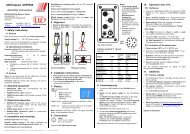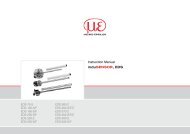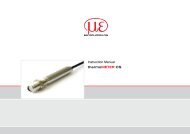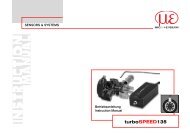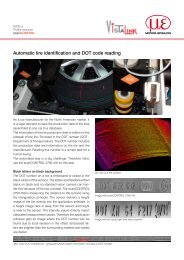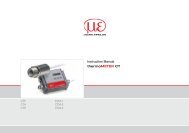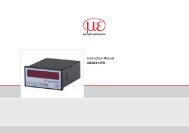optoNCDT 1607/1627 - Micro-Epsilon
optoNCDT 1607/1627 - Micro-Epsilon
optoNCDT 1607/1627 - Micro-Epsilon
You also want an ePaper? Increase the reach of your titles
YUMPU automatically turns print PDFs into web optimized ePapers that Google loves.
Instruction Manual<strong>optoNCDT</strong> <strong>1607</strong>/<strong>1627</strong>LD<strong>1607</strong>-0.5LD<strong>1607</strong>-2LD<strong>1607</strong>-4LD<strong>1607</strong>-10LD<strong>1607</strong>-20LD<strong>1607</strong>-50LD<strong>1607</strong>-100LD<strong>1607</strong>-200LD<strong>1627</strong>-2LD<strong>1627</strong>-4LD<strong>1627</strong>-10LD<strong>1627</strong>-20LD<strong>1627</strong>-50LD<strong>1627</strong>-100LD<strong>1627</strong>-200
Laser optical displacement measuringMICRO-EPSILONMESSTECHNIKGmbH & Co. KGKönigbacher Strasse 1594496 Ortenburg / GermanyTel. 08542/168-0Fax 08542/168-90e-mail info@micro-epsilon.dewww.micro-epsilon.comCertified in compliance with DIN EN ISO 9001: 2008
Contents1. Safety........................................................................................................................................... 51.1 Symbols Used..................................................................................................................................................... 51.2 Warnings............................................................................................................................................................. 51.3 Notes on CE Identification.................................................................................................................................. 61.4 Proper Use.......................................................................................................................................................... 61.5 Proper Environment............................................................................................................................................ 72. Laser Class.................................................................................................................................. 72.1 Class 2 Lasers..................................................................................................................................................... 72.2 Class 3R Lasers.................................................................................................................................................. 93. Functional Principle, Technical Data........................................................................................ 113.1 Short Description.............................................................................................................................................. 113.2 Technical Data LD<strong>1607</strong>..................................................................................................................................... 123.3 Technical Data LD<strong>1627</strong>..................................................................................................................................... 143.4 LED Indicator Elements ................................................................................................................................... 164. Delivery...................................................................................................................................... 174.1 Scope of Delivery.............................................................................................................................................. 174.2 Storage.............................................................................................................................................................. 175. Installation................................................................................................................................. 185.1 Sensor Mounting............................................................................................................................................... 185.2 Sensor Cable.................................................................................................................................................... 205.3 Power Supply and Output................................................................................................................................ 205.4 Controller........................................................................................................................................................... 226. Operation................................................................................................................................... 236.1 Getting Ready for Operation ............................................................................................................................ 236.2 Laser Diode Control Input................................................................................................................................. 236.3 Linearization...................................................................................................................................................... 236.4 Rise Time and Frequency Response................................................................................................................ 246.5 Noise................................................................................................................................................................. 246.6 Integration Time................................................................................................................................................ 256.7 Measuring Accuracy, Repeatability.................................................................................................................. 256.8 Analog Outputs................................................................................................................................................. 26<strong>optoNCDT</strong> <strong>1607</strong>/<strong>1627</strong>
6.9 Thresholds Min and Max, Range OK................................................................................................................ 276.10 Error Output, Light Intensity.............................................................................................................................. 286.11 Test Report........................................................................................................................................................ 287. Instructions for Operating........................................................................................................ 297.1 Self-test............................................................................................................................................................. 297.2 Surface-dependent Measurement Errors......................................................................................................... 297.2.1 Impairment due to Material and Color.............................................................................................................. 297.2.2 Surface Reflection............................................................................................................................................. 297.2.3 Scratch within the Measurement Spot............................................................................................................. 297.2.4 Lateral Scattered Light...................................................................................................................................... 307.2.5 Penetration of the Beam into the Measurement Object................................................................................... 307.2.6 Lined Objects.................................................................................................................................................... 307.2.7 Light/Dark Change within the Measurement Point........................................................................................... 307.2.8 Change in Surface Reflection during Measurement........................................................................................ 317.2.9 Sensor Orientation with Moving or Lined Measurement Objects.................................................................... 317.3 Thickness Measurement................................................................................................................................... 327.4 Angle Dependency of Measurements.............................................................................................................. 327.5 Assynchronous Measurement.......................................................................................................................... 337.6 Possible Interferences....................................................................................................................................... 347.6.1 Optical Interferences......................................................................................................................................... 347.6.2 Electrical Interferences..................................................................................................................................... 348. Serial Interface RS232.............................................................................................................. 358.1 Interface Parameters......................................................................................................................................... 358.2 Data Format for Measurement Values and Error Codes ................................................................................. 358.3 Transmission Mode and Baud Rate................................................................................................................. 368.4 Digital Output.................................................................................................................................................... 378.5 Pin Assignment Connection Cable................................................................................................................... 379. Protective Housing.................................................................................................................... 389.1 LD16x7 with Integrated Protective Window...................................................................................................... 389.2 Protective Housing for Sensors........................................................................................................................ 3910. Warranty..................................................................................................................................... 4111. Decommissioning, Disposal..................................................................................................... 4112. Appendix.................................................................................................................................... 42<strong>optoNCDT</strong> <strong>1607</strong>/<strong>1627</strong>
Safety1. Safety1.1 Symbols UsedThe handling of the sensor assumes knowledge of the instruction manual. The following symbols are used inthis instruction manual:WARNING! - potentially dangerous situationIMPORTANT!- useful tips and information1.2 WarningsAvoid unnecessary laser radiation to be exposed to the human body- Switch off the sensor for cleaning and maintenance.- Switch off the sensor for system mainte-nance and repair if the sensor is integrated into a system.• Caution - use of controls or adjustments or performance of procedures other than those specifiedherein may result in hazardous radiation exposure• Avoid banging and knocking the sensor and the controller> Damage to or destruction of the sensor and/or controller• The power supply may not exceed the specified limits> Damage to or destruction of the sensor and/or controller• Power supply and the display-/output device must be connected in accordance with the safetyregulations for electrical equipment> Danger of injury> Damage to or destruction of the sensor and/or controller• Protect the sensor cable against damage> Damage to or destruction of the sensor> Failure of the measuring device<strong>optoNCDT</strong> <strong>1607</strong>/<strong>1627</strong>Page 5
Safety1.3 Notes on CE IdentificationThe following applies to the <strong>optoNCDT</strong><strong>1607</strong>/<strong>1627</strong>:EMC regulation 2004/108/ECProducts which carry the CE mark satisfy the requirements of the EMC regulation 2004/108/EC ‘ElectromagneticCompatibility’ and the European standards (EN) listed therein. The EC declaration of conformity is kept availableaccording to EC regulation, article 10 by the authorities responsible atMICRO-EPSILON MESSTECHNIKGmbH & Co. KGKönigbacher Str. 15D-94496 OrtenburgThe system is designed for use in industry and to satisfy the requirements of the standards• EN 61000-6-4: 2001• EN 61000-6-2 :2001The system satisfies the requirements if they comply with the regulations described in the operating manual forinstallation and operation.1.4 Proper Use--It is used• for measuring displacement, distance, position and elongation• for in-process quality control and dimensional testing--The sensor may only be operated within the limits specified in the technical data, see Chap. 3.2, see Chap. 3.3.--The system should only be used in such a way that in case of malfunctions or failure personnel or machineryare not endangered.--Additional precautions for safety and damage prevention must be taken for safety-related applications.<strong>optoNCDT</strong> <strong>1607</strong>/<strong>1627</strong>Page 6
Laser ClassIMPORTANT!The protection classis limited to water (nopenetrating liquids orsimilar)IMPORTANT!Comply with all regulationson lasers.1.5 Proper Environment--Protection class• Sensor: IP 64 (Only with sensor cable connected )• Controller: IP 40--Lenses are excluded from protection class. Contamination of the lenses leads to impairment orfailure of the function.--Operating temperature: 0 to +50 °C (+32 to +104 °F)--Storage temperature: -20 to +70 °C (-4 to +158 °F)--Humidity: 5 - 90 % (no condensation)--Pressure: atmospheric pressure--EMC: acc. to - EN 61000-6-4: 2001- EN 61000-6-2: 20012. Laser ClassWhen operating the sensors, the relevant regulations according to EN 60825-1(IEC 60825, Part 1 of 11/2001) and the applicable accident prevention regulations must be followed.2.1 Class 2 LasersThe <strong>optoNCDT</strong><strong>1607</strong>/<strong>1627</strong> sensors operate with a semiconductor laser with a wavelength of 670 nm(visible/ red). The laser is operated on a pulsed mode, the pulse frequency does not correspond to the measuringfrequency. The duration of the pulse is regulated in dependency on the object to be measured andcan form an almost permanent beam. The maximum optical power is ≤ 1 mW. The sensors fall within LaserClass 2 (II). Class 2 (II) lasers are not notifiable and a laser protection officer is not required either.The housing of the optical sensors may only be opened by the manufacturer. For repair and servicepurposes the sensors must always be sent to the manufacturer.The laser warning labels for Germany have already been applied, see Fig. 2. Those for other non Germanspeakingcountries an IEC standard label and a FDA label are included in delivery and the versions applicableto the user’s country must be applied before the equipment is used for the first time.The following warning labels are attached to the cover (front and/or rear side) of the sensor housing:<strong>optoNCDT</strong> <strong>1607</strong>/<strong>1627</strong>Page 7
Laser ClassWARNING!Never deliberately lookinto the laser beam!Consciously closeyour eyes or turn awayimmediately if ever thelaser beam should hityour eyes.IEC StandardDuring operation of the sensor the pertinentregulations acc. to EN 60825-1 on „radiationsafety of laser equipment“ must be fully observedat all times.FDA labelThe sensor complies with all applicable laws for themanufacturer of laser devices. This system is classifiedby the Center for Devices and Radiological Health(CDRH) as a Class II laser device.Although the laser output is low looking directly into the laser beam must be avoided. Due to the visible lightbeam eye protection is ensured by the natural blink reflex.IMPORTANT!If both informationlabels are hidden in theinstalled state, the usermust ensure that additionallabels are fitted atthe point of installation.LaserspotLaserspotLaserspotFig. 1 True reproduction of the sensor with its actual location of the warning label<strong>optoNCDT</strong> <strong>1607</strong>/<strong>1627</strong>Page 8
Laser ClassFig. 2 True reproduction of the sensor withits actual location of the type labelIMPORTANT!Comply with all regulationson lasers.WARNING!The available laserradiation is hazardousfor the eye. Never deliberatelylook into thelaser beam! Consciouslyclose your eyes orturn away immediatelyif ever the laser beamshould hit your eyes.<strong>optoNCDT</strong> <strong>1607</strong>/<strong>1627</strong>2.2 Class 3R LasersThe LD<strong>1627</strong>-100 and LD<strong>1627</strong>-200 sensors operate with a semiconductor laser with a wavelength of 670 nm(visible/red). The laser is operated on a pulsed mode, the pulse frequency does not correspond to the measuringfrequency. The maximum optical power is ≤ 2.8 mW. The sensors fall within Laser Class 3R.The available laser radiation is hazardous for the eyes. Looking directely into the laser beam is hazardous forthe eyes. Also reflections on shining or mirroring surfaces are hazardous for the eyes.The housing of the optical sensors may only be opened by the manufacturer. For repair and servicepurposes the sensors must always be sent to the manufacturer.The laser warning labels for Germany have already been applied, see Fig. 2. Those for other non Germanspeakingcountries an IEC standard label is included in delivery and the version applicable to the user’scountry must be applied before the equipment is used for the first time.Class 3R lasers are not notifiable and a laser protection officer is not required either.The following warning label is attached to the cover (front and/or rear side) of the sensor housing:Page 9
Laser ClassIEC StandardDuring operation of the sensor the pertinent regulationsacc. to EN 60825-1 on „radiation safety of laser equipment“must be fully observed at all times.Although the laser output is low looking directly into the laser beam must be avoided. Due to the visible lightbeam eye protection is ensured by the natural blink reflex.IMPORTANT!If both informationlabels are hidden in theinstalled state, the usermust ensure that additionallabels are fitted atthe point of installation.Fig. 3 True reproduction of the sensor with its actual location of the warning label<strong>optoNCDT</strong> <strong>1607</strong>/<strong>1627</strong>Page 10
Laser ClassFig. 4 True reproduction of thesensor with its actual location ofthe type labelSMR = Start of measuringrangeMR = Measuring rangeEMR = End of measuringrange3. Functional Principle, Technical Data3.1 Short DescriptionThe <strong>optoNCDT</strong>16x7 consists of an laser-optical sensor anda signal conditioning electronics. The sensor uses the principleof optical triangulation, i.e. a visible, modulated pointof light is projected onto the target surface.The diffuse element of the reflection of the light spot is imagedby a receiver optical element positioned at a certainangle to the optical axis of the laser beam onto a highsensitivityresolution element (PSD element), in dependencyon distance. From the output signal of the PSD element thecontroller calculates the distance between the light spot onthe object being measured and the sensor. The distance islinearized and then issued via an analog or digital interface.Reference distanceMR SMRAnalog output-10 VDC 4 mA0 VDC 12 mA+10 VDC 20 mAFig. 5 Definition of terms, output signal<strong>optoNCDT</strong> <strong>1607</strong>/<strong>1627</strong>Page 11
Functional Principle, Technical Data3.2 Technical Data LD<strong>1607</strong>Sensor LD <strong>1607</strong>-Type 0.5 2 4 10 20 50 100 200Measuring range mm ( “)0.5(.02)Start of measuring range mm 23.75(.93)Reference distance 1(=midrange)mm24(.94)End of measuring range mm 24.25(.95)2(.08)23(.91)24(.94)25(.98)4(.16)22(.87)24(.94)26(1.02)10(.39)40(1.57)45(1.77)50(1.97)20(.79)55(2.17)65(2.56)75(2.95)50(1.97)95(3.74)120(4.72)145(5.71)100(3.94)170(6.69)220(8.66)270(10.6)Linearity μm 1 4 8 20 40 100 200 400Resolution (noise) 2 static, μm 0.1 0.5 1 3 6 20 30 60Spot diameter mm 0.1 0.2 0.3 0.6 0.9 1.5 1.5 2Limit frequencyLight sourceLaser classPermissible ambient lightLife time (MTBF)Isolation voltage10 kHz, 7 kHz, 4 kHz, 1 kHz, 250 Hz, 100 Hz, 25 Hz or 15 Hz(-3 dB), selectable with DIP switchesLaser, 1 mW, wavelength: 670 nm, red2 (DIN EN 60825-1 :2001-11, II (FDA)20.000 lx100.000 h for laser diode200 VDC, 0 V against housingMax. vibration 2 g up to 1 kHz (IEC 68-2-6)200(7.87)240(9.45)340(13.4)440(17.3)All specifications apply for a diffusely reflecting matt white ceramic target.1) Referenzed on the horizontal housing edge of the sensors respectively on midrange.2) Frequency response 15 Hz.<strong>optoNCDT</strong> <strong>1607</strong>/<strong>1627</strong>Page 12
Functional Principle, Technical DataSensor LD <strong>1607</strong>-Type 0.5 2 4 10 20 50 100 200Shock 15 g (IEC 68-2-6)Operating temperature0 bis +50 °C (32 to 122 °F)Storage temperature-20 bis +70 °C (-4 to 158 °F)Air humiditybis 90 % (no condensation)Temperature stability 0.02 % / °CProtection classSensorIP 64ControllerIP 40Supply voltage24 VDC (10 up to 30 VDC) / 200 mAAnalog outputDisplacement±10 VDC / 4 ... 20 mA / RS232Intensity0 ... 10 VDCSensor cable2 m (6 ft)Elektromagnetic compatibility(EMC)EN 61000-6-4: 2001EN 61000-6-2 :2001Sensor weight (with 2 m cable) 250 g 240 g 400 gController weight274 g<strong>optoNCDT</strong> <strong>1607</strong>/<strong>1627</strong>Page 13
Functional Principle, Technical Data3.3 Technical Data LD<strong>1627</strong>Sensor LD <strong>1627</strong>-Type 2 4 10 20 50 100 200Measuring range mm ( “)Start of measuring rangeReference distance 1(=midrange)End of measuring rangemmmmmm2(.08)23(.91)24(.94)25(.98)4(.16)22(.87)24(.94)261.02)10(.39)40(1.57)45(1.77)50(1.97)20(.79)55(2.17)65(2.56)75(2.95)50(1.97)95(3.74)120(4.72)145(5.71)100(3.94)170(6.69)220(8.66)270(10.6)200(7.87)240(9.45)340(13.4)440(17.3)Linearity μm 6 12 30 60 150 300 600Resolution (noise) 2 static, μm 1 2 6 12 30 40 120Spot diameter mm 0.2 0.3 0.6 0.9 1.5 1.5 2Frequency responseLight sourceLaser classPermissible ambient lightLife time (MTBF)kHz37 / 30 / 25 / 20 / 10 / 5 / 2.5 (-3 dB),selectable with DIP switchesLaser, P £ 1 mW,Wavelenght: 670 nm, red2DIN EN 60825-1: 2001-1120.000 lx100.000 h for laser diodeLaser, P £ 2.8 mW,l = 670 nm, red3RIEC 60825-1: 2003-101) All specifications apply for a diffusely reflecting matt white ceramic target.2) Frequency response 15 Hz.<strong>optoNCDT</strong> <strong>1607</strong>/<strong>1627</strong>Page 14
Functional Principle, Technical DataSensor LD <strong>1627</strong>-Type 2 4 10 20 50 100 200Isolation voltage200 VDC, 0 V against housingMax. vibration 2 g bis 1 kHz (IEC 68-2-6)Shock 15 g (IEC 68-2-6)Operating temperatureStorage temperatureAir humidity0 bis +50 °C (32 to 122 °F)-20 bis +70 °C (-4 to 158 °F)bis 90 % (no condensation)Temperature stability 0.02 % / °CProtection classSupply voltageAnalog outputSensorControllerDisplacementIntensityIP 64IP 4024 VDC (10 up to 30 VDC) / 200 mA±10 VDC / 4 ... 20 mA / RS2320 ... 10 VDCSensor cable2 m (6 ft)Elektromagnetic compatibility(EMC)EN 61000-6-4: 2001EN 61000-6-2 :2001Sensor weight (mit 2 m cable) 240 g 400 gController weight274 g<strong>optoNCDT</strong> <strong>1607</strong>/<strong>1627</strong>Page 15
Functional Principle, Technical Data3.4 LED Indicator ElementsLED Color MeaningPOWER green Power onFig. 6 LEDs on the controllerMAX o red MAX value is exceededOKgreenLED level indicator OK showsthe position of the target withinthe set limits.MIN o yellow Value drops below the set MIN.ERROR o red Too little light is reflected.Fig. 7 Meanings of the LEDs in measurement modeNote: In measurement mode (factory setting) only theLED „Power“ and „OK“ lights up, subject to the current positionof the object to be measured.<strong>optoNCDT</strong> <strong>1607</strong>/<strong>1627</strong>Page 16
Delivery4. Delivery4.1 Scope of Delivery1 Controller1 Sensor with 2 m connecting cable and cable jack2 Laser warning labels in accordance with IEC standards1 25 pin D-SUB receptacle1 Instruction manual1 Test reportCheck for completeness and shipping damage immediately after unpacking. In case of damage or missingparts, please contact the manufacturer or supplier.4.2 StorageStorage temperature:Humidity:-20 bis +70 °C (-4 to +158 °F)up to 90 % (no condensation)<strong>optoNCDT</strong> <strong>1607</strong>/<strong>1627</strong>Page 17
Installation5. InstallationThe <strong>optoNCDT</strong>16x7 is an optical sensor for measurementswith micrometer accuracy. Make sure it is handled carefullywhen installing and operating.5.1 Sensor MountingIMPORTANT!Handle opticalsensors with care.• The laser beam must be directed perpendicularly onto thesurface of the target. In case of misalignment it is possiblethat the measurement results will not always be accurate, seeChap. 7.2.9.• The LED‘s MIN, OK and MAX help to adjust the sensor.Default settings of MIN, OK and MAX are the sensors rangelimits. OK lights up if the sensor is within the measuring range.30 (1.18)17 ( 67)2x M4• If the sensors are to be used in soiled environments or inhigher ambient temperatures than normal, MICRO-EPSILONrecommends the use of SGx1605 protective housings, seeChap. 9.2.• Mount the sensor LD 16x7 - 0.5 by means of 2 screws typeM4.50 (1 97)46 (1.81)4 (.16)20 (.79)mm(inches)22 ( 87)8.5( 33)26 (1 02)50 (1.97)Fig. 8 Sensor dimensions LD 16x7 - 0.5 (not to scale)21 ( 83)9.5( 37)<strong>optoNCDT</strong> <strong>1607</strong>/<strong>1627</strong>Page 18
Installation30 (1.18)17 ( 67)2x M440 (1.57)24 (.94)76 (2.99)3x M434 (1 34)50 (1.97)16 (.63)4(.16)46 (1 81)8.5(.33)20 (.79)50 (1.97)7(.28)12.5(.49) 50 (1.97)82.3 (3.24)100 (3.94)13(.51)29 (1.14)4.8(.19)4 (.16)46 (1 81)50 (1 97)11(.19)42 (1.65)21 (.83)9.5( 37)14 (.55) 6( 24)9-pin D-Sub21 (.83)Abb. 9 Sensor dimensionsLD 16x7 - 2 / 4 / 10 / 20 (not to scale)• Mount the sensor LD 16x7 - 2 / 4 / 10 / 20by means of 2 screws type M4.Abb. 10 Sensor dimensionsLD 16x7 - 50 / 100 / 200 (not to scale)• Mount the sensor LD 16x7 - 50 / 100 / 200 bymeans of 3 screws type M4.<strong>optoNCDT</strong> <strong>1607</strong>/<strong>1627</strong>Page 19
Installation5.2 Sensor Cable• Never bend the sensor cable by more than the bending radius.• The sensor comes with a permanently mounted sensor cable of 2 m in length. Do not shorten the sensorcable or modify it. Failure of the measuring device and/or loss of specified technical data.• Never lay signal leads next to or together with power cables or pulse-loaded cables (e.g. for drive unitsand solenoid valves) in a bundle or in cable ducts. Always use separate ducts.• Connect the sensor cable to the controller.Cable bendingR > 10 one timeR > 35 alternatingIMPORTANT!Useful accessories:- Power supplyPS 2010Input 230/115 VAC,Output 24 VDC/2.5 A- PC1605-3Interconnecting cable,3 m long(supply / outputs)5.3 Power Supply and OutputProvide the power supply for the controller. To do this connect- the connecting cable PC1605 (available as an accessory)- or a cable made up by the user1) to the 25-pole SUB-D connector (OUTPUT/POWER, see Fig. 11) on the controller,2) to a power supply +24 VDC.Connect the measurement signal displays and recording devices to the controller. To do this connect- the connecting cable PC1605-3 or PC1605-3/RS232 (both available as accessory)- or a cable made up by the user1) to the 25-pole SUB-D connector (OUTPUT/POWER, see Fig. 11) on the controller2) to measurement signal displays or recording devices.• Recommended strand cross-section for self-made connection cables: ≥ 0.2 mm² (AWG 24).• Check the plugged connections for firm seating.<strong>optoNCDT</strong> <strong>1607</strong>/<strong>1627</strong>Page 20
InstallationPin 14Pin 1Fig. 11 25-pin power and output connector,view on solder pin sideInnercable areaOutercable area25-pinSUB-DAssignment Color PC16051 Sensor signal ±10 VDC green14 Analog GNDbluescreen20 Intensity 0 ... 10 VDC red2 Error, +24 VDC/10 mA grey3 Laser OFF white8 Ground, power supply brown21 +24 VDC supply green6 Sensor signal 4 ... 20 mA yellow25-pinSUB-D Assignment 9-polSUB-D4 TxD 25 Range OK, +24 VDC/10 mA7 RxD 38 RS232 GND 516 MAX, +24 VDC/10 mA18 RTS 819 MIN, +24 VDC/10 mAFig. 12 Pin assignment of the 25-pole SUB-D connector for power supply and output<strong>optoNCDT</strong> <strong>1607</strong>/<strong>1627</strong>Page 21
Installation5.4 ControllerThe controller is mounted by means of 4 screws type M4 DIN 84. When mounting the controller keep the LEDdisplays free for watching.Output / powerconnection36 (1.42)9-pol. D-SubSensor connectorSensorconnection39 (1.54)16 (.63)29 (1.14)64 (2.52)74 (2 91)92 (3 62)102 (4 02)mm(inches)4(.16)ø8 (dia. .31)ø4.4 (dia. .17)4x Mounting hole27 (1 06)Fig. 13 Dimensions and mounting method for controller.<strong>optoNCDT</strong> <strong>1607</strong>/<strong>1627</strong>Page 22
Operation6. Operation6.1 Getting Ready for OperationInstall and assemble the <strong>optoNCDT</strong>16x7 in accordance with the instructions set out, see Chap. 5..Once the operating voltage has been switched on the controller runs through an initialization sequence. Thisis indicated by the momentary activation of all the LEDs.To be able to produce reproducible measurements the sensor typically requires a start-up time of 10 minutes.Once this has elapsed the sensor will be in measurement mode and the “POWER“ and “OK“ LED on thecontroller will be illuminated.IMPORTANT!The laser diode in thesensor will only beactivated if the input„Laser on/off“ is NOTconnected to GND.6.2 Laser Diode Control InputThe laser beam can be switched off during NON use if pin 3 of the output connector of the controller is connectedto GND (0 V). Alternatively to it you may switch off the laser, if the DIP-switches SW7 and SW8, are inposition ON, see Fig. 22.6.3 LinearizationThe receiver element (PSD) in the sensor supplies a nonlinear output voltage for the distance, causing alinearization to take place in the evaluation electronics. This takes into account various surface reflectionfactors and supplies a proportional voltage for the measuring distance.<strong>optoNCDT</strong> <strong>1607</strong>/<strong>1627</strong>Page 23
OperationIMPORTANT!Selectable reactiontimes LD <strong>1607</strong>:0.1/ ... /67 msec, seeChap. 6.6IMPORTANT!Longer reaction/integrationtime reducesthe noise.6.4 Rise Time and Frequency ResponseThe rise time of the analog output is very fast. This time amounts to approx. 100 µsec for a rise to 90 % of thefinal value. The use of DIP switches in the controller can increase the rise/integration time, whereby noise isreduced and measuring accuracy is improved.6.5 NoiseThe system generates various levels of noise, depending on the degree of reflection from the object. Withgood scattered light reflection (matt white), noise is reduced. Noise limits the sensor resolution. Extending theintegration time, see Chap. 6.6, considerably reduces the noise.<strong>optoNCDT</strong> <strong>1607</strong>/<strong>1627</strong>Page 24
Operation6.6 Integration TimeThe switches (DIP switch S4/S5/S6, see Fig. 15) must be flipped to ON in order to select the integration time.All switches flipped to OFF corresponds to an integration time of 67 msec for the LD<strong>1607</strong>.LD<strong>1627</strong>Integrationtimeµsec 27 33 40 50 67 100 200 400LD<strong>1607</strong>Frequency kHz 37 30 25 20 15 10 5 2.5SW4 On Off On Off On Off On OffSW5 On On Off Off On On Off OffSW6 On On On On Off Off Off OffIntegrationtimemsec 0.1 0.14 0.25 1 4 10 40 67<strong>optoNCDT</strong>OUTPUT/POWERON2 3 4 5 6 7 8SENSOR1 2 3 4 5 6 7 8ONFrequency kHz 10 7 4 1 0.25 0.1 0.025 0.015Fig. 14 Selecting the integration time for the sensorFig. 15 Localization of the DIPswitches on the controllerIMPORTANT!Surface structurescreated by lathing,milling, etc. can distortreadings.<strong>optoNCDT</strong> <strong>1607</strong>/<strong>1627</strong>6.7 Measuring Accuracy, RepeatabilityUnlike mechanical measuring systems, the optical displacement sensor does not exhibit any hysteresis orinconsistent repeat accuracies. Accuracy is limited by noise, linearity and surface condition. Observe theaccuracy and temperature frequency of the mechanical conditions when using for measurements in the µmrange. With mechanically processed parts (lathing, milling, grinding), the formation of mini prisms and mirroringon the grooved surface structure can distort results. The sensor always should be used with its lens axispointing in the direction of the grind marks.Page 25
OperationIMPORTANT!Outputvoltage: ±10 VDCcurrent: 0 ... 20 mASignal increases instrength up to +10 V,the farther away themeasurement object isfrom the sensor.IMPORTANT!Caution:The signal voltagewill again fall back to±10 V if the measuringrange is over orundershot.6.8 Analog OutputsThe displacement signal is shown asthe voltage [expressed in V] or current[expressed in mA] proportional to the distance[expressed in mm]. The zero pointor reference distance is in the middle ofthe measuring range; objects farther awayyield a positive voltage (up to +10 V),while closer objects yield a negativevoltage.The „Light intensity“ analog outputsupplies additional information on theintensity of the reflected light. Voltageranges from 0 to 10 V. Surfaces with goodreflection properties yield approx. 7 V. Thecontrol mechanism reduces the transmittedlight intensity at +4 V. The voltage isproportional to the light intensity of the reflectedlight. Below 1 V the sensor is at thelimit of detection; very distorted readingsand increased noise are the result.Fig. 16 Output characteristic of displacementsignalLight intensity108642-2-4-6-8-10Analog [V]20412ouput [mA]Measuring rangeMeasurementobjectDisplacementsignal<strong>optoNCDT</strong> <strong>1607</strong>/<strong>1627</strong>Page 26
OperationoMeasuredvalue+24 VGND+24 VGND+24 VGNDU U RNERONR RMAXMINRange OKPoti 1MIN thresholdPoti 2MAX thresholdt6.9 Thresholds Min and Max, Range OKThe <strong>optoNCDT</strong> series 16x7 has two switching levels in the controller thatcan be adjusted with a screwdriver for minimum and maximum thresholdvalues. The thresholds can be adjusted over the entire measuring range.Each threshold operates with a small hysteresis, approx. 0.4 % from themeasuring range, in order to prevent fluttering during slow transitions.When the minimum is undershot, the MIN output activates; the OK outputis switched on in the interim.It should be noted that the switching levels are only unique within themeasuring range. If the object is much closer or farther away than thepermitted measuring range, ambiguities can occur. In order to simplifyinitial application, the limit values are set at the factory to the correct limitsof the application range:MAX, Pot 2: +10 VMIN, Pot 1: -10 VIf the upper limit is exceeded the assigned output (pin 16 of the 25-poleSUB-D connector) will be activated and deactivated again with the followonshortfall on the upper hysteresis value. The same applies in principleto a shortfall on the lower limit (pin 19 of the 25-pole SUB-D connector),see Chap. 5.3 for more details. The range OK output is assigned to pin 5of the 25-pole SUB-D connector.Electrical charateristicsOutput active: +24 VDC / 10 mA max.Output passive: near 0 VFig. 17 Signal sequence for the thresholds and range OK<strong>optoNCDT</strong> <strong>1607</strong>/<strong>1627</strong>Page 27
Operation6.10 Error Output, Light IntensityThe intensity of the diffuse reflected light creates a signal in the sensor proportional to the intensity or brightnessof the spot. This signal is an indicator of „how good is this measurement“. If the light intensity is too lowor too high the error output (pin 2 of the 25-pole SUB-D connector, see Chap. 5.3 will be activated.Electrical characteristicsError output active: +24 VDC / 10 mA max.Error output passive: near 0 V6.11 Test ReportEach sensor comes with a test report that graphically depicts the individual measurement error of the sensorin enlarged format. The measurement error is shown relative and absolute for matt white measurementsurfaces.<strong>optoNCDT</strong> <strong>1607</strong>/<strong>1627</strong>Page 28
Instructions for Operating7. Instructions for Operating7.1 Self-testPermanent monitoring of the reflected light checks to see if an object is in the measuring range or if the intensityof the reflected light is sufficient.7.2 Surface-dependent Measurement Errors7.2.1 Impairment due to Material and ColorMeasurement objects are made from all possible materials, including metal, plastic, ceramic, rubber, paper,etc. Only in the case of highly reflective surfaces or liquids must the application (use of the instrument) beindividually checked (tested). Measurement cannot be done on transparent objects such as glass or highlyreflective surfaces.IMPORTANT!Diffuse reflection of atleast 10 %.Scratches can simulatechanged distances.7.2.2 Surface ReflectionThe sensor requires a minimal surface reflection of 10 % for fault-free operation. Only diffuse reflection can beused for measurements.7.2.3 Scratch within the Measurement SpotA scratch on the measurement object whose direction is transverse to the lens axis (transmission lens, receivinglens) can cause very strong light emissions, whereby the intensity of the emissions is highest next to thecenter of the light spot. This simulates a change in distance.Substantially higher degrees of measuring accuracy can be achieved with this effect than with pure distancemeasurement when testing surfaces for scratches.If it is a moving object that is in question, the mean (integral) reading remains constant while scanning thescratch area, i.e. the positive and negative flanks (caused by the scratch) cancel each other out.<strong>optoNCDT</strong> <strong>1607</strong>/<strong>1627</strong>Page 29
Instructions for Operating7.2.4 Lateral Scattered LightWhen the light spot is projected, there is a certain (minimal) amount of lateral scattered light reflected fromthe side of the measurement point that reaches the receiver. If there are highly reflective parts close to themeasurement point in the area of the scattered light that reflect this light directly back to the receiver, measurementerrors can result.Objects that scatter homogenous light with an equal degree of reflection do not cause this error. If the reflectivearea is outside of the measurement point, the error rate will be no higher than 2 %.7.2.5 Penetration of the Beam into the Measurement ObjectWith semi-transparent plastics or cloudy liquids, the measuring beam penetrates a certain amount into themedium before the diffusely reflected light is sent back. Here, the true measurement plane is expanded toinclude the penetration depth. In isolated cases, this can only be determined by experimentation.7.2.6 Lined ObjectsIf the measurement objects have light/dark lines on them (e.g. wood), the sensor must be mounted with itslongitudinal axis parallel to the line direction. Here, laser sensors yield a better result, due to their smallermeasurement point.7.2.7 Light/Dark Change within the Measurement PointIf a displacement measurement is taken at an area that transitions from a diffusely reflecting material to areflecting material (which translates into a severely changing reflection factor), measurement errors can resultin this transition area. The maximum light intensity is here (due to the surface), not in the center of the measurementpoint. If the transition border line is in the direction of lens axis A (sensor longitudinal axis), error isminimal; error is greatest in axis B, see Fig. 21.<strong>optoNCDT</strong> <strong>1607</strong>/<strong>1627</strong>Page 30
Instructions for Operating7.2.8 Change in Surface Reflection during MeasurementThe optical sensor has an automatic light intensity regulation mechanism in order to adapt to highly reflectiveand semi-reflective media. If the surface emission changes during the measuring process, the sensor automaticallyadapts.7.2.9 Sensor Orientation with Moving or Lined Measurement ObjectsIf moving or lined objects are to be measured, the sensor should be mounted with its long side transverse tothe direction of motion and parallel to the lines. This allows better measurement results in edge areas.Color stripsDirection of movementFig. 18 Sensor arrangement in case ofground or striped surfacesGrinding or rolling marksIn case of bore holes, blind holes, andedges in the surface of moving targets thesensor must be arranged in such a way thatthe edges do not obscure the laser spot,see Fig. 19.CorrectIncorrect(shadow)Fig. 19 Sensor arrangement for holes andridges<strong>optoNCDT</strong> <strong>1607</strong>/<strong>1627</strong>Page 31
Instructions for Operating7.3 Thickness MeasurementThe thickness of a measurement object can be calculated by usingtwo sensors, mounted on opposite sides. The thickness is attainedby adding the measuring signals. Output voltage ranges from 0 to+10 V. The scanning range corresponds to the measuring range of asensor. Within this range, thickness measurement is nearly independentof the position. The scanning range should be a little larger thanthe change in depth to be measured, plus the range of motion.Each sensor is equipped with separate evaluation electronics. Thelight measurement pulses are synchronized, with both systems operatingisolated from each other so that thin, transparent materials alsocan be measured without one of the sensors influencing the otherwith its transmitted light pulses.Fig. 20 Thickness measurementIMPORTANT!Measurement erroris lower for mattsurfaces with severelydiffuse reflection thanfor more reflectivesurfaces.7.4 Angle Dependency of MeasurementsMeasurement is slightly angle-dependent if the sensor is not perpendicularto the object surface. The angle dependency for matt surfaceswith a high degree of diffuse reflection is minimal. Angle dependencyis less when tilted around the A axis of rotation than when tiltedaround axis B.The angle of rotation of the object around axis A can reach 30 °without causing any significant measurement error, whereas only 15 °is possible around axis B. Measurement error is present when the relationshipbetween output voltage and distance changes. If the angleis constant, the influence can be eliminated by recalibrating.±15 °A-axis±30 ° B-axisFig. 21 Max. tilt of the object,definition of axis/orientation<strong>optoNCDT</strong> <strong>1607</strong>/<strong>1627</strong>Page 32
Instructions for Operating7.5 Assynchronous MeasurementIf two sensors are located in a short distance to each other, a mutual interference by the adjoining laser lightis possible.Relief: Both sensors measure alternately.Procedure:--Connect both controllers with the cable PC<strong>1607</strong>-3(01).--Define the status of• controller 1 as master• controller 2 as slave.Status Master SlaveSW7 On OffSW8 Off Off<strong>optoNCDT</strong>OUTPUT/POWER1 2 3 4 5 6 7 8ONSENSOR1 2 3 4 5 6 7 8ONFig. 22 View with SW7 / SW8In the mode asynchronous measurement the limit frequency decreases from 10 kHz to 7 kHz (LD<strong>1607</strong>) andfrom 37 kHz to 24 kHz at the LD<strong>1627</strong>.<strong>optoNCDT</strong> <strong>1607</strong>/<strong>1627</strong>Page 33
Instructions for Operating7.6 Possible Interferences7.6.1 Optical Interferences• Do not let welding flashes cross the sensor when arc welding.• Sunlight cast on the measurement object impairs measurement, resulting in minimal deviation error.• Sunlight cast directly on the sensor can considerably reduce its accuracy.• Light from tubular fluorescent lamps or incandescent lamps does not have a negative effect.7.6.2 Electrical Interferences• Power cables with high interference voltage running parallel to the sensor feed.• Heavy interference on the 24 V supply line, e.g. half-wave rectification without charging capacitor.The sensor housing is isolated to keep the sensor away from interference, however the analog ground isrouted to the housing ground via a 0.1 µF/200 V capacitor. The housing of the controller also is isolated. Theelectronic ground is routed to the housing with a 0.1 µF/200 V capacitor.<strong>optoNCDT</strong> <strong>1607</strong>/<strong>1627</strong>Page 34
Serial Interface RS2328. Serial Interface RS2328.1 Interface ParametersThe <strong>optoNCDT</strong>16x7 comes with a RS232 serial interface to enable the sensor to be operated from astandard computer and measurement values and error codes to be transferred.Data format: 8 Data bits, no parity, one stop bit (8, N, 1)The factory-set baud rate is 115.2 kBaud but it can be programmed to 9.6 kBaud by dip switch on the controller.8.2 Data Format for Measurement Values and Error CodesThe data word is comprised of two consecutive bytes (H-byte/L-byte). One flag bit in each byte differentiatesa high from a low byte.Start 1 7 Bit MSB Stop Start 0 7 Bit LSB StopConversion of the binary data format:For conversion purposes the high and low bytes must be identified on the basis of the first bit (flag bit), theflag bits and status bits deleted and the remaining bits compiled into 12 bit data word.Reception:H-Byte 1 D11 D10 D9 D8 D7 SB2 SB1H-Byte 0 D6 D5 D4 D3 D2 D1 D0SB2 SB1 Status bits0 0 Range OK0 1 MIN1 0 MAX1 1 ERROR<strong>optoNCDT</strong> <strong>1607</strong>/<strong>1627</strong>Page 35
Serial Interface RS232Result of conversionD11 D10 D9 D8 D7 D6 D5 D4 D3 D2 D1 D0Conversion must be done in the application program.8.3 Transmission Mode and Baud RateThe controller supports the RTS mode for communication with theAD-converter.Factory settingThe RTS mode requires to receive the „ready to send“ (RTS) signalfrom the computer. RTS remains high as long as the computer isready to receive data. After a read request to the COM port data aretransmitted until the COM port is open. At high baud rates the COMbuffer could get full. This may happen either at a quick read or whenclosing the COM port.Transmission mode --- RTSSW1 Off OnTransmission mode9.6kBaud19.2kBaud38.4kBaud115.2kBaudSW2 On Off On OffSW3 On On Off Off<strong>optoNCDT</strong>OUTPUT/POWER1 2 3 4 5 6 7 8ONSENSOR1 2 3 4 5 6 7 8ON<strong>optoNCDT</strong> <strong>1607</strong>/<strong>1627</strong>Page 36
Serial Interface RS2328.4 Digital OutputThe data word contains the two bytes (H-byte/L-byte) and start and stop bits. So 20 bits are transmitted permeasurement. The measurement frequency can be calculated from the baud rate diveded through 20 bits.Start 1 7 Bit MSB Stop Start 0 7 Bit LSB StopAD converter output code:Output voltage D11 D10 D9 D8 D7 D6 D5 D4 D3 D2 D1 D0+10.235 0 1 1 1 1 1 1 1 1 1 1 1+0.005 0 0 0 0 0 0 0 0 0 0 0 10 0 0 0 0 0 0 0 0 0 0 0 0-0.005 1 1 1 1 1 1 1 1 1 1 1 1-10.24 1 0 0 0 0 0 0 0 0 0 0 08.5 Pin Assignment Connection CableHardware handshake connections :- Connect pin 1 + 4 + 6 and- Connect pin 7 + 8 of the 9 pin SUB-D connectorThe above connections are necessary when no softwarehandshake and no hardware handshake signals are available.9-pin SUB-D Function 25-pin SUB-D1DCDconnect4 DTRpins6 DSR2 RXD 43 TXD 75 GND 87 connect RTS 188 pins CTS<strong>optoNCDT</strong> <strong>1607</strong>/<strong>1627</strong>Page 37
Protective Housing9. Protective HousingThe protective housing are designed to be used especially if the sensor operates in a dirty environmentor higher ambient temperature. It is available as an accessory. Installation of the sensors in the protectivehousings should be performed by the manufacturer, because especially in case of short reference distancesthe protective window must be included in the calibration.9.1 LD16x7 with Integrated Protective WindowRecommended for soiled environments, for quick cleaning of thesmooth plastic pane. The sensor has a smooth underside (withoutprotruding conduits for transmitter and receiver optics).30 (1.18)17 ( 67)Available for LD 16x7 - 2 / 4 / 10 / 20• Mount the sensor LD 16x7 - 2 / 4 / 10 / 20 by means of 2 screwstype M4.Legend:mm(inches)61 (2.40)57 (2.24)4 (.16)20 (0.79)2 mountingholes for M48.5 Laser beam(.33) 50 (1.97)<strong>optoNCDT</strong> <strong>1607</strong>/<strong>1627</strong>Fig. 23 LD16x7 with integrated protective window21 (.83)9.5(.37)Protective windowPage 38
Protective Housing9.2 Protective Housing for SensorsSGL 1605SGF 1605- with compressed air connection- with window5.5 (.22)74 (2 91)63 (2.48) 58 (2 28)CableCompressedairLegend:mm(inches)80 (3.15)52 (2.05)2 mountingholes for M4screws14(.55)Glass12.5(.49)20.5 (.81) Laser beam26 (1.02)Fig. 24 Protective housing for LD16x7 - 2/4/10/20<strong>optoNCDT</strong> <strong>1607</strong>/<strong>1627</strong>Page 39
Protective HousingSGL 1605SGF 1605- with compressed air connection- with windowCable125 (4 92)119 (4 69) 58 (2.28)CompressedairLegend:mm(inches)2 mountingholes for M4screws14(.55)23 (.91)80 (3.15)66 (2 60)6(.24)23.5 (.93)Laser beam Glass 21 (.83)Fig. 25 Protective housing for LD16x7 - 50/100/200<strong>optoNCDT</strong> <strong>1607</strong>/<strong>1627</strong>Page 40
Warranty10. WarrantyAll components of the device have been checked and tested for perfect function in the factory. In the unlikelyevent that errors should occur despite our thorough quality control, this should be reported immediately toMICRO-EPSILON MESSTECHNIK.The warranty period lasts 12 months following the day of shipment. Defective parts, except wear parts, will berepaired or replaced free of charge within this period if you return the device free of cost to MICRO-EPSILONMESSTECHNIK.This warranty does not apply to damage resulting from abuse of the equipment and devices, from forcefulhandling or installation of the devices or from repair or modifications performed by third parties.No other claims, except as warranted, are accepted. The terms of the purchasing contract apply in full.MICRO-EPSILON MESSTECHNIK will specifically not be responsible for eventual consequential damages.MICRO-EPSILON MESSTECHNIK always strives to supply the customers with the finest and most advancedequipment. Development and refinement is therefore performed continuously and the right to design changeswithout prior notice is accordingly reserved.For translations in other languages, the data and statements in the German language operation manual areto be taken as authoritative.11. Decommissioning, Disposal- Disconnect the power supply and output cable on the controller.- Disconnect the sensor cable between sensor and controller.The <strong>optoNCDT</strong>16x7 is produced according to the directive 2011/65/EU („RoHS“). The disposal is done accordingto the legal regulations (see directive 2002/96/EC).<strong>optoNCDT</strong> <strong>1607</strong>/<strong>1627</strong>Page 41
Appendix12. AppendixAccessories:PC1605 - 3Supply- and ouput-cable, 3 m longPC<strong>1607</strong>-3/RS232Supply- and ouput-cable,3 m long with 9-pin. Sub-D connector for RS232PC<strong>1607</strong>-3(01)Power supply and output cable, 3 m long, for asynchron measurementCSP 301Digital signal processing unit with display, programmable for 2 analog signalsPS2020Power supply 24 V for mounting on DIN-rail, input 230 VAC, output 24 VDC/2.5 ASGF 1605Aluminium protection housingwith glass window and air connection with blowing the air along the glass windowSensor-cable in lengths up to 5 m<strong>optoNCDT</strong> <strong>1607</strong>/<strong>1627</strong>Page 42
Appendix<strong>optoNCDT</strong> <strong>1607</strong>/<strong>1627</strong>Page 43
MICRO-EPSILON MESSTECHNIK GmbH & Co. KGKönigbacher Str. 15 · 94496 Ortenburg / GermanyTel. +49 (0) 8542 / 168-0 · Fax +49 (0) 8542 / 168-90info@micro-epsilon.de · www.micro-epsilon.comX9751007-D101014HDRMICRO-EPSILON MESSTECHNIK*X9751007-D10*






